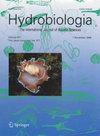Relations length-dry weight of nymphs Anacroneuria caraca Stark, 1995 and A. marta Zúñiga and Stark, 2002 (Plecoptera:Perlidae) from a neotropical mountain rive
IF 0.3
4区 生物学
Q4 MARINE & FRESHWATER BIOLOGY
引用次数: 0
Abstract
Background: The study of the morphometry in aquatic insects is very important to understand some ecological processes such as biomass gain, development time of the species and the dynamics of the cohorts. In Colombia, there are no studies on length-dry weight relations at the species level in Anacroneuria nymphs. Goals: The aim of this study was to analyze the morphological characteristic of Anacroneuria marta and A. caraca and to determine possible linear functions that explain the relations between some body dimensions (total length and head width) versus dry weight. Methods: Organisms were collected in areas of rapids and pools of the Gaira River (Sierra Nevada of Santa Marta, Colombia) between October 2014 and March 2015. Nymphs were identified to species level and taxonomic entities were confirmed by a discriminate analysis, using measurements of ten morphological variables. In some organisms dry weight was obtained, which was correlated with length measurements by simple linear regressions. Results: The species A. marta and A. caraca showed statistically significant morphological differences, which confirmed these taxa. The power model was the best adjusted to show the relations of the total length (TL) and the width of the head (WH) with the dry weight (p <0.01). Conclusions: The relationships between body dimensions and dry weight were highly significant, for A. marta the best adjust was with the WH and for A. caraca was with TL, with explanations of 86% and 95% of the variations in biomass, respectively. These equations will serve as a basis for studies of determination of biomass in Plecoptera nymphs.新热带山区河流中小叶蝉(Anacroneuria caraca Stark, 1995)和小叶蝉(a . marta Zúñiga and Stark, 2002)的长度-干重关系
背景:研究水生昆虫的形态计量学对于了解生物量的增加、物种的发育时间和种群的动态等生态过程非常重要。在哥伦比亚,没有关于Anacroneuria若虫在物种水平上的长度-干重关系的研究。目的:本研究的目的是分析马氏Anacroneuria marta和A.caraca的形态特征,并确定可能的线性函数,以解释某些身体尺寸(总长度和头部宽度)与干重之间的关系。方法:在2014年10月至2015年3月期间,在盖拉河(哥伦比亚圣玛尔塔内华达山脉)的急流和水池区域采集生物体。通过对10个形态变量的测量,对睡莲进行了物种级鉴定,并通过判别分析确认了分类实体。在一些生物体中获得了干重,通过简单的线性回归将其与长度测量值相关联。结果:A.marta和A.caraca的形态差异具有统计学意义,证实了这两个类群的存在。功率模型最适合显示总长度(TL)和头部宽度(WH)与干重的关系(p<0.01)。这些方程将为Plecoptera若虫生物量测定的研究奠定基础。
本文章由计算机程序翻译,如有差异,请以英文原文为准。
求助全文
约1分钟内获得全文
求助全文
来源期刊

Hidrobiologica
生物-海洋与淡水生物学
CiteScore
0.40
自引率
0.00%
发文量
8
审稿时长
>12 weeks
期刊介绍:
HIDROBIOLÓGICA es una publicación cuatrimestral que difunde trabajos originales e inéditos de investigación o revisión, sobre temas relacionados con los organismos y la hidrología de los ambientes acuáticos, dulces y marinos y va dirigida a investigadores de todo el mundo, interesados en las diversas disciplinas que incluye la Hidrobiología , así como a alumnos de posgrados y licenciaturas relacionados con la biología, ecología, taxonomía, filogenia y evolución de organismos acuáticos, e hidrología y oceanografía de ambientes s dulceacuícolas y marinos.
 求助内容:
求助内容: 应助结果提醒方式:
应助结果提醒方式:


